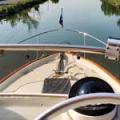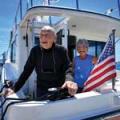Reviews-Sailboat-Racing
An Armchair Perspective
By John Andrews
A review of several of the author’s favorite books on the subject.
The sport of sailboat racing relieves the unbearable leisure of cruising around, back and forth—going, as they say, nowhere fast. It endows the simple joy of sailing with an aura of “performance” (speed, tactical cunning, athleticism, cutthroat competitiveness, etc.), otherwise known in polite circles as “helmsmanship.”
Sailing, by itself, obviously fails to involve enough pain. It lacks what racing supplies—stress, physical discomfort, and, to be sure, an element of danger—all requisite for this particular type of combat to be rightfully called “sporting.”
In racing it helps that most sailboats are admirably sleek, and that some are just plain fast in the water. Yet it is disconcerting to discover that how fast depends not only on inherent design speed, but also on boat conditioning and handling. Performance, alas, falls largely on the sailor.
“You should read all the racing books you can get your hands on,” advises C. Stanley Ogilvy in Win More Sailboat Races (1976). A one-design champion (Star and Etchells 22), Ogilvy wrote enthusiastically about racing and its history until his death in January 2000. Reading “won’t work miracles for you,” he admits, but the “helpful nuggets” one is likely to find “here and there” are worth the effort.
In my own case, though miracles are admittedly preferable, I rest content with Ogilvy’s suggestion for the simple reason that scavenging books on sailboating is such fun.
Indeed, Win More Races is one of several in my meager library of instructional reference works that continue to offer up bits of revealed wisdom in a rich slumgullion (ref. The Sea Scout Manual) of personal experience and history.
One of these books is a fairly new title, Getting Started in Sailboat Racing (2005), by Adam Cort and Richard Stearns (published by International Marine, part of McGraw-Hill). It is an up-to-date introduction to the “software” of racing: basic boat handling, racing tactics, and rules of the road. The book covers what are generally known as fundamentals, serving to remind us that the sport of sailboat racing is fundamentally abstruse, arcane, and, except for a handful of brilliant millionaires, inherently incomprehensible.
Cort and Stearns make a valiant effort to dispel one’s natural fears about racing (they act chatty and tell a few stories). But the reader becomes increasingly suspicious when, for example, the rules of racing, which are described in Chapter 1 as being “all about common sense,” become—as exceptions and qualifications casually appear— “fairly straightforward” in Chapter 4, then “a bit complicated” in Chapter 5, and, finally, “a bit confusing” in Chapter 6, where the authors are moved to disclaim, cheerily: “Still, the rules are not half as complicated or mysterious as some sailors would have you believe.”
Getting Started affords the novice a great deal to ponder and doubt, including a lengthy exposition on sail controls. This vital and wondrously elusive subject—involving science, technology, and folklore—is served up surreptitiously, embedded in three pertinent topics: wind (light to heavy), tacking (to windward and downwind), and rigging (for sail shape and trim). The latter discussion takes up, one by one, the various onboard sail controls (halyards, sheets, outhaul, traveler, cunningham, vang, jib leads, etc.) that we sailors have come to recognize, respect, and despise.
An older book in my collection takes up these contrivances in a similarly systematic yet less scientific manner. It is Fundamentals of Sailboat Racing (1973) by Stephen Falk, a brief how-to manual that reserves “more technical explanations” to four lengthy appendices at the end of the book. The first of these covers the basic sail controls (“How to rig the boat for the wind of the day”), while another appendix, curiously, is a reprint of a booklet titled Sail & Air, by sailmakers Charles Ulmer and John Stanton, on the aerodynamics of sailing.
If one hasn’t already wised up, this exegesis on aerodynamics is one more example why the physics of sailing, like instructions for a CD player or a quick guide to string theory, should be relegated to a secluded place for later reading, such as an appendix, or perhaps jettisoned to the omnivorous gods of the sea. We don’t need to know why a sailboat sails, but how to sail it—especially when the experts themselves seem to disagree so decidedly about what causes the blessed thing to move at all.
Falk’s Fundamentals offers a tasty array of how-to tips on sailing smartly—and fast. Those that interest an individual reader, of course, are those likely to help overcome one’s own deficiencies, lapses, or plain ignorance. Thus, in reading Falk recently, I myself took special note of these personally relevant tidbits:
Backwind effect (especially in the area windward abeam, “for up to two or three mast-lengths”)
Weight distribution (“...far enough forward so that the bottom of the transom just kisses the water”)
Vang (set while chose-hauled “before you fall off onto the downwind leg”)
Another book I find particularly ripe for cherry-picking timely tips is The Tactics of Small Boat Racing (1966) by Stuart H. Walker, M.D., a one-design sailor who has written a handful of books on racing tactics. This one, conveniently, is a compilation of magazine articles rather than a single narrative, so it can easily be browsed, using the chapter titles for guidance to subjects of interest.
Walker demonstrates his profession as a teacher—of pediatric medicine—by concluding each essay with a brief “moral.” (Each chapter also begins with a quotation, and a nice sketch by Carol H. Little.) These summary lessons can be both instructive and amusing, witness the ending of a chapter that is, I fear, relevant to my situation (“Slow Boat? Fast Boat?”):
“Though there are ways for the slow boat to win,” he writes, “the fast boat always has the advantage. Once slowness is recognized it should be corrected. Go home and correct the impaired balance, the poor sail trim, the excess weight, the surface resistance, and return to victory!”
Victory! Success! That’s the ticket. Once slowness is recognized it should be corrected. Go home! Reform, improve, and win! The good doctor prescribes surgery for both boat and sailor. Fix the boat, and discipline the sailor—using organization, strategy, observation, and rigor.
Dr. Walker may be a pedant, but he is not alone in his enthusiasm for single-mindedness. He shares this view with his compatriots on my bookshelf, each one of whom has a slightly different spin. Ogilvy tells the story of a discouraged skipper who reversed his fortunes in a single season by resolutely deciding to “take his racing seriously.” And Falk talks about “trying harder...all of the time.”
As to winning, attitude helps, or so they say.
I wouldn’t know.
Win More Sailboat Races by C. Stanley Ogilvy W.W. Norton & Co. New York, 1976 132 pages, out of print. Getting Started in Sailboat Racing by Adam Cort and Richard Stearns International Marine (McGraw-Hill) Camden, 2005, Softcover, 212 pages Fundamentals of Sailboat Racing by Stephen Falk St. Martin's Press, New York, 1973 142 pages, out of print The Tactics of Small Boat Racing by Stuart H. Walker, M.D. W.W. Norton & Co., New York, 1966 Softcover, 333 pages |
Retired editor John Andrews lives in Bridgton, Maine, and is active in the Lake Region Sailing Club on Long Lake.
Related Articles
Share this article:
2023 Maine Boat & Home Show

Join Us for the Maine Boat & Home Show!
Art, Artisans, Food, Fun & Boats, Boats, Boats
August 11 - 13, 2023 | On the waterfront, Rockland, Maine
Click here to pre-order your tickets.
Show is produced by Maine Boats, Homes & Harbors magazine.















